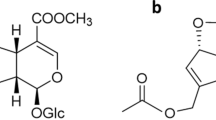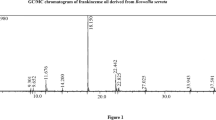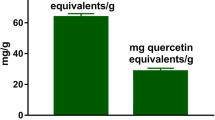Abstract
In the present study, we investigated the effects of lipoic acid (LA) in the brain oxidative stress caused by pilocarpine-induced seizures in adult rats. Wistar rats were treated with 0.9% saline (i.p., control group), lipoic acid (10 mg/kg, i.p., LA group), pilocarpine (400 mg/kg, i.p., pilocarpine group), and the association of LA (10 mg/kg, i.p.) plus pilocarpine (400 mg/kg, i.p.), 30 min before the administration of LA (LA plus pilocarpine group). After the treatments, all groups were observed for 1 h. The enzyme activities [δ-aminolevulinic dehydratase (δ-ALA-D), glutathione peroxidase (GPx), glutathione reductase (GR), and Na+,K+-ATPase] as well as the glutathione-reduced (GSH) and ascorbic acid (AA) concentrations were measured using spectrophotometric methods, and the results were compared to values obtained from saline and pilocarpine-treated animals. Protective effects of LA were also evaluated on the same parameters. In pilocarpine group, no changes were observed in GPx and GR activities and AA content. Moreover, in the same group, decrease in GSH levels as well as a reduction in δ-ALA-D and Na+,K+-ATPase activities after seizures was observed. In turn, in LA plus pilocarpine group, the appearance of seizures was abolished, and the decreases in δ-ALA-D and Na+,K+-ATPase activities produced by seizures as well as increases in GSH levels and GPx activity were reversed, when compared to the pilocarpine seizing group. The results of the present study demonstrated that preadministration of LA abolished seizure episodes induced by pilocarpine in rat, probably by reducing oxidative stress in rat hippocampus caused by seizures.



Similar content being viewed by others
References
Ahamed M, Fareed M, Kumar A, Siddiqui WA, Siddiqui MKJ (2008) Oxidative stress and neurological disorders in relation to blood lead levels in children. Redox Rep 13:117–122
Bustamante J, Lodge JK, Marcocci L, Tritschler HJ, Packer L, Rihn BH (1998) α-Lipoic acid in liver metabolism and disease. Free Radic Biol Med 24:1023–1039
Cammack J, Ghasemzadeh B, Adams RN (1992) Electrochemical monitoring of brain ascorbic acid changes associated with hypoxia, spreading depression, and seizure activity. Neurochem Res 17:23–27
Carlberg I, Mannervik B (1985) Glutathione reductase. Methods Enzymol 113:484–489
Cruz-Aguado R, Francis-Turner L, Díaz-Suárez CM, Bergado J (1999) NGF prevents changes in rat brain glutathione-related enzymes following transection of the septo hippocampal pathway. Neurochem Int 34:125–130
Cruz-Aguado R, Almaguer-Melian W, Diaz CM, Lorigados L, Bergado J (2001) Behavioral and biochemical effects of glutathione depletion in the rat brain. Brain Res Bull 55:327–333
Erakovié V, Zupan G, Varljen J, Laginja J, Simonié A (2000) Lithium plus pilocarpine induced status epilepticus—biochemical changes. Neurosci Res 36:157–166
Fiske CH, Subbarow YJ (1925) The colorimetric determination of phosphorus. Biol Chem 66:375–381
Freitas RM (2009) The evaluation of effects of lipoic acid on the lipid peroxidation, nitrite formation and antioxidant enzymes in the hippocampus of rats after pilocarpine-induced seizures. Neurosci Lett 455:140–144
Freitas RM, Vasconcelos SMM, Souza FCF, Viana GSB, Fonteles MF (2005) Oxidative stress in the hippocampus after pilocarpine-induced status epilepticus in Wistar rats. FEBS J 272:1307–1312
Genestra M (1997) Oxyl radicals, redox-sensitive signalling cascades and antioxidants. Free Radic Biol Med 22:359–378
Heales SJ, Davies SEC, Bates T, Clark JB (1995) Depletion of brain glutathione is accompanied by impaired mitochondrial function and decreased N-acetyl aspartate concentration. Neurochem Res 20:31–38
Hissin PJ, Hilf R (1976) Fluorometric method for determination of oxidized and reduced glutathione in tissues analytical. Biochemistry 74:214–226
Jacques-Silva MC, Nogueira CW, Broch LC, Rocha JBT (2001) Diphenyl diselenide and ascorbic acid changes deposition of selenium and ascorbic acid in brain of mice. Pharmacol Toxicol 88:119–125
Keenoy BMY, Vertommen J, De Leeuw I (2001) Divergent effects of different oxidants on glutathione homeostasis and protein damage in erythrocytes from diabetic patients: effects of high glucose. Mol Cell Biochem 225:59–73
Kim HC, Bing G, Jhoo WK, Kim WK, Shin EJ, Park ES, Choi YS, Lee DW, Shin CY, Ryu JR, Ko KH (2002) Oxidative damage causes formation of lipofuscin-like substances in the hippocampus of the senescence-accelerated mouse after kainate treatment. Behav Brain Res 131:211–220
Kutluhan S, Nazıroğlu M, Çelik O, Yılmaz M (2009) Effects of selenium and topiramate on lipid peroxidation and antioxidant vitamin levels in blood of pentylentetrazol-induced epileptic rats. Biol Trace Elem Res 129:181–189
Lei XG, Cheng WH (2009) New roles for an old selenoenzyme: from glutathione peroxidase-1 null and over expressing mice. Recent Adv Nutr Res 12:2295–2297
Lima FD, Souza MA, Furian AF, Rambo LM, Ribeiro LR, Martignoni FV, Hoffmann MS, Fighera MR, Royes LFF, Oliveira MS, Mello CF (2008) Na+,K+-ATPase activity impairment after experimental traumatic brain injury: relationship to spatial learning deficits and oxidative stress. Behav Brain Res 193:306–310
Mueller SG, Trabesinger AH, Boesiger P, Wieser HG (2001) Brain glutathione levels in patients with epilepsy measured by in vivo 1H-MRS. Neurology 57:422–1427
Packer L, Witt EH, Tritschler HJ (1995) Alpha-lipoic acid as a biological antioxidant. Free Radic Biol Med 19:227–250
Packer L, Tritschler HJ, Wessel K (1997) Neuroprotection by the metabolic antioxidant alpha-lipoic acid. Free Radic Biol Med 22:359–378
Patsoukis N, Zervoudakis G, Georgiou CD, Angelatou F, Matsokis NA, Panagopoulos NT (2004) Effect of pentylenetetrazol-induced epileptic seizure on thiol redox state in the mouse cerebral cortex. Epilepsy Res 62:65–74
Poon F, Calabrese V, Scapagnini G, Butterfield DA (2004) Free radicals: key to brain aging and heme oxygenase as a cellular response to oxidative stress. J Gerontol 59:478–493
Prigol M, Wilhelm EA, Schneider CC, Rocha JBT, Nogueira CW, Zeni G (2007) Involvement of oxidative stress in seizures induced by diphenyl diselenide in rat pups. Brain Res 1147:226–232
Rauca C, Zerbe R, Jantze H (1999) Formation of free hydroxyl radicals after pentylenetetrazol-induced seizure and kindling. Brain Res 847:347–351
Sassa S (1982) Delta-aminolevulinic acid dehydratase assay. Enzyme 28:133–145
Shin EJ, Suh SK, Lim YK, Jhoo WK, Hjelle OP, Ottersen OP, Shin CY, Ko KH, Kim WK, Kim DS, Chun W, Ali S, Kim HC (2005) Ascorbate attenuates trimethyltin-induced oxidative burden and neuronal degeneration in the RST hippocampus by maintaining glutathione homeostasis. Neuroscience 133:715–727
Shin EJ, Ko KH, Kim WK, Chae JS, Yen TPH, Kim HJ, Wie MB, Kim HC (2008) Role of glutathione peroxidase in the ontogeny of hippocampal oxidative stress and kainate seizure sensitivity in the genetically epilepsy-prone rats. Neurochem Int 52:1134–1147
Sies H (1999) Glutathione and its role in cellular functions. Free Radic Biol Med 27:916–921
Skaper SD, Ancona B, Facci L, Franceschini D, Giusti P (1998) Melatonin prevents the delayed death of hippocampal neurons induced by enhanced excitatory neurotransmission and the nitridergic pathway. FASEB J 12:725–731
Sleven H, Gibbs JE, Heales S, Thom M, Cock HR (2006) Depletion of reduced glutathione precedes inactivation of mitochondrial enzymes following limbic status epilepticus in the rat hippocampus. Neurochem Int 48:75–82
Ullrich S, Zhang Y, Avram D, Ranta F, Kuhl D, Häring HU, Lang F (2007) Dexamethasone increases Na+/K+ ATPase activity in insulin secreting cells through SGK1. Biochem Biophys Res Commun 352:662–667
Wendel A (1981) Glutathione peroxidase. Methods Enzymol 77:325–333
Acknowledgments
We would like to thank Stenio Gardel Maia for her technical assistance. This work was supported in part by grants from CNPq, Brazil.
Author information
Authors and Affiliations
Corresponding author
Rights and permissions
About this article
Cite this article
de Freitas, R.M. Lipoic Acid Alters δ-Aminolevulinic Dehydratase, Glutathione Peroxidase and Na+,K+-ATPase Activities and Glutathione-Reduced Levels in Rat Hippocampus After Pilocarpine-Induced Seizures. Cell Mol Neurobiol 30, 381–387 (2010). https://doi.org/10.1007/s10571-009-9460-9
Received:
Accepted:
Published:
Issue Date:
DOI: https://doi.org/10.1007/s10571-009-9460-9




